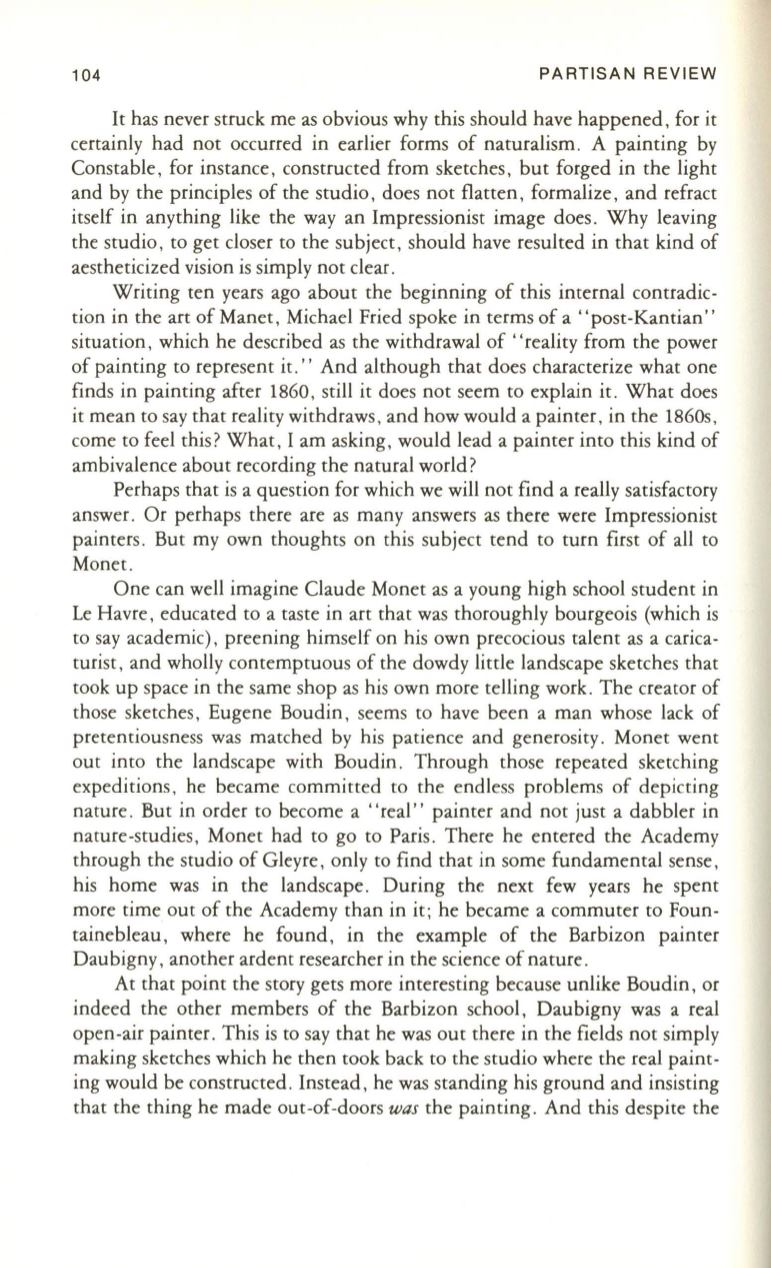
104
PARTISAN REVIEW
It
has never struck me as obvious why this should have happened, for it
certainly had not occurred in earlier forms of naturalism. A painting by
Constable, for instance, constructed from sketches, but forged in the light
and by the principles of the studio, does not flatten, formalize, and refract
itself in anything like the wayan Impressionist image does . Why leaving
the studio, to get closer to the subject, should have resulted in that kind of
aestheticized vision is simply not clear .
Writing ten years ago about the beginning of this internal contradic–
tion in the art of Manet, Michael Fried spoke in terms of a "post-Kantian"
situation, which he described as the withdrawal of "reality from the power
of painting to represent it ." And although that does characterize what one
finds in painting after 1860, still it does not seem to explain it. What does
it mean to say that reality withdraws, and how would a painter , in the 1860s,
come to feel this? What, I am asking, would lead a painter into this kind of
ambivalence about recording the natural world?
Perhaps that is a question for which we will not find a really satisfactory
answer. Or perhaps there are as many answers as there were Impressionist
painters. But my own thoughts on this subject tend to turn first of all to
Monet.
One can well imagine Claude Monet as a young high school student in
Le Havre, educated to a taste in art that was thoroughly bourgeois (which is
to say academic), preening himself on his own precocious talent as a carica–
turist, and wholly contemptuous of the dowdy little landscape sketches that
took up space in the same shop as his own more telling work. The creator of
those sketches, Eugene Boudin , seems to have been a man whose lack of
pretentiousness was matched by his patience and generosity. Monet went
out into the landscape with Boudin. Through those repeated sketching
expeditions, he became committed to the endless problems of depicting
nature . But in order to become a "real" painter and not just a dabbler in
nature-studies, Monet had to go to Paris . There he entered the Academy
through the studio of Gleyre, only to find that in some fundamental sense,
his home was in the landscape. During the next few years he spent
more time out of the Academy than in it; he became a commuter to Foun–
tainebleau, where he found, in the example of the Barbizon painter
Daubigny , another ardent researcher in the science of nature .
At that point the story gets more interesting because unlike Boudin, or
indeed the other members of the Barbizon school, Daubigny was a real
open-air painter. This is to say that he was out there in the fields not simply
making sketches which he then took back to the studio where the real paint–
ing would be constructed . Instead, he was standing his ground and insisting
that the thing he made out-of-doors
was
the painting . And this despite the


